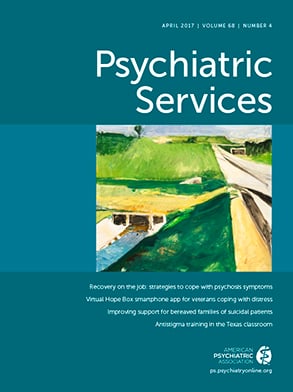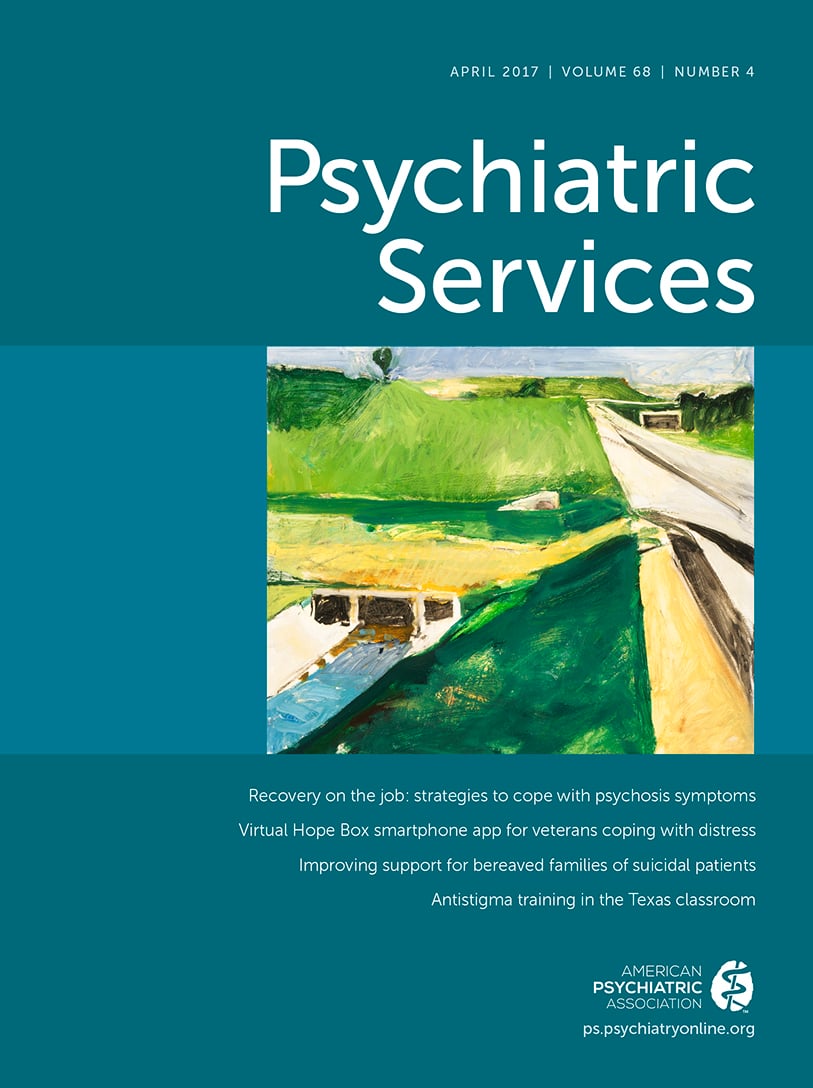Incarcerated Women’s Experiences and Beliefs About Psychotropic Medication: An Empirical Study
Abstract
Objective:
Methods:
Results:
Conclusions:
Methods
Participants
Measure
Data Analysis
Results
Sample Characteristics
| Characteristic | N | % |
|---|---|---|
| Age group | ||
| 18–24 | 13 | 5 |
| 25–34 | 101 | 37 |
| 35–44 | 90 | 33 |
| 45–54 | 56 | 20 |
| 55–64 | 14 | 5 |
| ≥65 | 0 | — |
| Race-ethnicity | ||
| White | 220 | 80 |
| African American | 40 | 15 |
| Multiracial | 5 | 2 |
| Native American | 4 | 2 |
| Hispanic | 3 | 1 |
| Asian or Pacific Islander | 2 | 1 |
| Psychiatric diagnosis | ||
| Anxiety disorder | 209 | 76 |
| Depressive disorder | 196 | 72 |
| Trauma-based disorder | 160 | 58 |
| Substance use disorder | 135 | 49 |
| Bipolar disorder | 128 | 47 |
| Sleep disorder | 86 | 31 |
| Personality disorder | 56 | 20 |
| Neurodevelopmental disorder | 53 | 19 |
| Psychotic disorder | 26 | 10 |
| Eating disorder | 19 | 7 |
| Variable | N | % |
|---|---|---|
| Medication type | ||
| Antidepressant | 198 | 93 |
| Antianxiety | 49 | 23 |
| Mood stabilizer | 71 | 33 |
| Antipsychotic | 27 | 13 |
| Stimulant | 1 | <1 |
| Current use | ||
| 1 type | 106 | 50 |
| 2 types | 76 | 36 |
| 3 types | 27 | 13 |
| 4 types | 4 | 2 |
Univariate Analyses
| Loading score | ||||||||
|---|---|---|---|---|---|---|---|---|
| Item | M | SD | 1 | 2 | 3 | 4 | 5 | 6 |
| For me, the good things about medication outweigh the bad. | 7.48 | 2.63 | .64 | .36 | –.04 | .29 | –.17 | –.13 |
| My medication helps me manage my mood and feel stable and relaxed. | 7.80 | 2.65 | .86 | .15 | –.09 | .13 | –.02 | –.09 |
| My medication reduces my symptoms. | 7.64 | 2.57 | .86 | .20 | –.07 | .11 | –.08 | –.04 |
| My medication clears my thoughts and makes it easier to focus. | 6.97 | 2.86 | .87 | .15 | –.08 | .08 | –.07 | –.05 |
| My medication helps me to feel normal. | 7.24 | 2.74 | .88 | .20 | –.12 | .06 | –.02 | .01 |
| My medication helps me cope with my incarceration. | 6.46 | 3.24 | .73 | .07 | .10 | –.03 | .04 | .12 |
| I expect to take medication for the rest of my life. | 6.15 | 3.72 | .11 | .80 | –.03 | .03 | .05 | –.04 |
| Medication is a life-changing godsend. | 5.84 | 3.27 | .18 | .78 | .05 | –.01 | .01 | .13 |
| Medication is an accepted fact of life. | 6.58 | 3.15 | .17 | .79 | –.03 | .10 | .03 | .01 |
| I am grateful for my medication and what it means for my life. | 7.11 | 2.93 | .46 | .70 | –.03 | .06 | –.16 | .08 |
| Sometimes, I give my medication to other offenders or trade it for things. | 1.09 | .73 | .02 | .04 | .50 | .01 | .13 | –.47 |
| My medication is a way the prison controls me. | 2.18 | 2.28 | –.17 | –.02 | .82 | –.12 | .04 | .10 |
| Medication is a sinister form of mind control. | 2.77 | 2.71 | –.02 | –.02 | .68 | –.03 | .27 | .14 |
| I take my medications of my own free choice. | 9.17 | 2.03 | .11 | .12 | –.15 | .78 | .02 | .13 |
| I play a role in making decisions about my medication. | 8.21 | 2.51 | .17 | –.02 | –.02 | .82 | –.08 | –.03 |
| Sometimes, I skip taking my medication. | 5.40 | 3.53 | –.14 | –.12 | .04 | .19 | .58 | –.22 |
| People view me negatively because I take medication. | 3.26 | 2.81 | –.02 | .15 | .18 | –.12 | .67 | .18 |
| I feel ashamed that I take medication. | 2.29 | 2.34 | –.01 | .02 | .39 | –.15 | .59 | –.09 |
| My medication causes unwanted physical side effects. | 6.12 | 3.41 | –.16 | –.12 | –.02 | –.06 | .48 | .57 |
| My emotions are dependent on whether or not I take medication. | 6.58 | 3.08 | .36 | .38 | .19 | –.04 | –.05 | .42 |
| Mental illness stems from biological causes. | 6.25 | 2.91 | –.06 | .20 | .22 | .23 | –.11 | .54 |
| I know the names and dosages of all my medications. | 8.37 | 2.90 | .23 | .24 | .19 | .22 | –.24 | .03 |
Exploratory Factor Analysis
Linear Regression
| Perception of therapeutic effectsa | Perception of impact of medication on lifeb | Perception of medication as a means of controlc | Perception of personal agency with medication used | Experience of stigma related to medication usee | Perception of biological vulnerabilityf | |||||||
|---|---|---|---|---|---|---|---|---|---|---|---|---|
| Variable | B | SE | B | SE | B | SE | B | SE | B | SE | B | SE |
| Age group | –.27 | .9 | 2.52** | .64 | –.47 | .3 | –.47 | .26 | –.13 | .39 | .14 | .36 |
| Race-ethnicity | –1.47 | .92 | –.13 | .66 | –.20 | .31 | –.35 | .27 | .20 | .40 | –.22 | .37 |
| N of incarcerations | .3 | .26 | .09 | .18 | –.12 | .09 | .09 | .08 | –.17 | .11 | –.07 | .11 |
| Years incarcerated | .35* | .17 | –.13 | .12 | .09 | .06 | –.04 | .05 | .22* | .07 | .08 | .07 |
| External locus of control | –.42 | .27 | .23 | .19 | .33** | .09 | –.16* | .08 | .35* | .12 | .35** | .11 |
| Current medication use | 10.33** | 1.96 | 8.2** | 1.39 | –.75 | .65 | 1.37* | .56 | –.56 | .86 | .07 | .79 |
| N of psychiatric diagnoses | .06 | .45 | 1.03** | .32 | –.06 | .15 | .05 | .13 | –.02 | .19 | 1.22** | .18 |
ANCOVA
Thematic Analysis of the Open-Ended Question
Discussion
Conclusions
Acknowledgments
Footnote
References
Information & Authors
Information
Published In

Cover: Freeway and Aqueduct, by Richard Diebenkorn, 1957. Oil on canvas. Gift of William and Regina Fadiman (M.86.68). Los Angeles County Museum of Art, Los Angeles. Digital image © 2017 Museum Associates/LACMA, Licensed by Art Resource, New York City.
History
Keywords
Authors
Funding Information
Metrics & Citations
Metrics
Citations
Export Citations
If you have the appropriate software installed, you can download article citation data to the citation manager of your choice. Simply select your manager software from the list below and click Download.
For more information or tips please see 'Downloading to a citation manager' in the Help menu.
View Options
View options
PDF/EPUB
View PDF/EPUBLogin options
Already a subscriber? Access your subscription through your login credentials or your institution for full access to this article.
Personal login Institutional Login Open Athens loginNot a subscriber?
PsychiatryOnline subscription options offer access to the DSM-5-TR® library, books, journals, CME, and patient resources. This all-in-one virtual library provides psychiatrists and mental health professionals with key resources for diagnosis, treatment, research, and professional development.
Need more help? PsychiatryOnline Customer Service may be reached by emailing [email protected] or by calling 800-368-5777 (in the U.S.) or 703-907-7322 (outside the U.S.).
